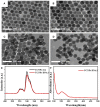A Fluorescence Resonance Energy Transfer Probe Based on DNA-Modified Upconversion and Gold Nanoparticles for Detection of Lead Ions
- PMID: 32373578
- PMCID: PMC7186500
- DOI: 10.3389/fchem.2020.00238
A Fluorescence Resonance Energy Transfer Probe Based on DNA-Modified Upconversion and Gold Nanoparticles for Detection of Lead Ions
Abstract
We report a new sensor for the specific detection of lead ions (Pb2+) in contaminated water based on fluorescence resonance energy transfer (FRET) between upconversion nanoparticles (UCNPs) as donors and gold nanoparticles (Au NPs) as receptors. The UCNPs modified with Pb2+ aptamers could bind to Au NPs, which were functionalized with complementary DNA through hybridization. The green fluorescence of UCNPs was quenched to a maximum rate of 80% due to the close proximity between the energy donor and the acceptor. In the presence of Pb2+, the FRET process was broken because Pb2+ induced the formation of G-quadruplexes from aptamers, resulting in unwound DNA duplexes and separated acceptors from donors. The fluorescence of UCNPs was restored, and the relative intensity had a significant linear correlation with Pb2+ concentration from 0 to 50 nM. The sensor had a detection limit as low as 4.1 nM in a buffer solution. More importantly, the sensor exhibited specific detection of Pb2+ in complex metal ions, demonstrating high selectivity in practical application. The developed FRET prober may open up a new insight into the specific detection of environmental pollution.
Keywords: DNA; fluorescence resonance energy transfer; gold nanoparticles; lead ions; upconversion nanoparticles.
Copyright © 2020 Wang, Lv, Chen, Deng, Liu, Fan and Zhang.
Figures






Similar articles
-
Dual fluorescence resonance energy transfer assay between tunable upconversion nanoparticles and controlled gold nanoparticles for the simultaneous detection of Pb²⁺ and Hg²⁺.Talanta. 2014 Oct;128:327-36. doi: 10.1016/j.talanta.2014.04.056. Epub 2014 Apr 30. Talanta. 2014. PMID: 25059168
-
Homogenous detection of fumonisin B(1) with a molecular beacon based on fluorescence resonance energy transfer between NaYF4: Yb, Ho upconversion nanoparticles and gold nanoparticles.Talanta. 2013 Nov 15;116:611-8. doi: 10.1016/j.talanta.2013.07.016. Epub 2013 Jul 27. Talanta. 2013. PMID: 24148452
-
An upconversion fluorescent resonant energy transfer biosensor for hepatitis B virus (HBV) DNA hybridization detection.Analyst. 2015 Nov 21;140(22):7622-8. doi: 10.1039/c5an01634g. Analyst. 2015. PMID: 26421323
-
Multiplexed fluorescence resonance energy transfer aptasensor between upconversion nanoparticles and graphene oxide for the simultaneous determination of mycotoxins.Anal Chem. 2012 Jul 17;84(14):6263-70. doi: 10.1021/ac301534w. Epub 2012 Jul 6. Anal Chem. 2012. PMID: 22816786
-
Turn-On Fluoresence Sensor for Hg2+ in Food Based on FRET between Aptamers-Functionalized Upconversion Nanoparticles and Gold Nanoparticles.J Agric Food Chem. 2018 Jun 20;66(24):6188-6195. doi: 10.1021/acs.jafc.8b00546. Epub 2018 Jun 7. J Agric Food Chem. 2018. PMID: 29847117
Cited by
-
Principles and Applications of Resonance Energy Transfer Involving Noble Metallic Nanoparticles.Materials (Basel). 2023 Apr 13;16(8):3083. doi: 10.3390/ma16083083. Materials (Basel). 2023. PMID: 37109920 Free PMC article. Review.
-
Detection of Hg2+ Using a Dual-Mode Biosensing Probe Constructed Using Ratiometric Fluorescent Copper Nanoclusters@Zirconia Metal-Organic Framework/N-Methyl Mesoporphyrin IX and Colorimetry G-Quadruplex/Hemin Peroxidase-Mimicking G-Quadruplex DNAzyme.BME Front. 2024 Dec 17;5:0078. doi: 10.34133/bmef.0078. eCollection 2024. BME Front. 2024. PMID: 39691776 Free PMC article.
-
Fluorescence-Based Sensing of Pesticides Using Supramolecular Chemistry.Front Chem. 2021 Apr 16;9:616815. doi: 10.3389/fchem.2021.616815. eCollection 2021. Front Chem. 2021. PMID: 33937184 Free PMC article. Review.
-
Advances in aptamer screening and aptasensors' detection of heavy metal ions.J Nanobiotechnology. 2021 Jun 1;19(1):166. doi: 10.1186/s12951-021-00914-4. J Nanobiotechnology. 2021. PMID: 34074287 Free PMC article. Review.
-
Heavy Metal Ions Trigger a Fluorescent Quenching in DNA-Organic Semiconductor Hybrid Assemblies.Polymers (Basel). 2022 Aug 31;14(17):3591. doi: 10.3390/polym14173591. Polymers (Basel). 2022. PMID: 36080666 Free PMC article.
References
-
- Bravo-Sanchez L. R., De La Riva B. S., Costa-Fernandez J. M., Pereiro R., Sanz-Medel A. (2001). Determination of lead and mercury in sea water by preconcentration in a flow injection system followed by atomic absorption spectrometry detection. Talanta 55, 1071–1078. 10.1016/S0039-9140(01)00523-9 - DOI - PubMed
-
- Chen G., Song F., Xiong X., Peng X. (2013). Fluorescent nanosensors based on Fluorescence Resonance Energy Transfer (FRET). Industr. Eng. Chem. Res. 52, 11228–11245. 10.1021/ie303485n - DOI
LinkOut - more resources
Full Text Sources

